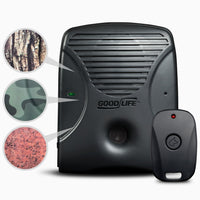Subtotal
CAD $0.00
or
Deaf dogs can be just as amazing and loving as any other dog, they just need a little bit more patience, training and care.
Hearing loss in dogs is often caused by a congenital defect which can cause them to be deaf in one or both ears. But it can also be caused from ear infections, injuries, or old age.
You have probably noticed at one time or another (whether online or by your own personal experience) that many deaf dogs are white. This is because these dogs typically carry a gene called the piebald gene which causes the dog to be born without melanocytes.
Melanocytes are cells that contain melanin, which determines the dog's coloration when they are born. The melanocytes help protect cells from damaging rays of sun. Dogs with the piebald gene are born without melanocytes, so they are unable to protect the layer of cells within the ear that allows the dog to hear thus resulting in deafness. These dogs are usually white in color with blue eyes.

Breeds that can carry the piebald gene are typically bull terriers (Pit Bulls), boxers, English setters and Dalmatians. 30% of Dalmatians are born deaf in one or both ears.
There is another congenital defect linked to deafness; the merle gene. This gene causes a dog to have a dappled coat and blue eyes. Merle dogs can be born healthy, but through careless breeding, two dogs with this gene can cause a litter of puppies to be almost entirely deaf or blind. Most common breeds with the merle gene are dapple dachshunds, old English Sheepdogs, Welsh corgis, and border collies.

There are a few ways to determine if your dog is deaf. In puppies you can tell if they don’t wake up during feeding time unless nudged, or they bite their litter-mates too hard because they can’t hear them yelp. Other things can be if they do not look at you when being called or with loud sudden noises like a squeaking toy, whistling, clapping or turning on the forever evil vacuum cleaner!
Caring for a deaf dog is a bit more complex than caring for a normal hearing dog, but it’s not anything that cannot be done. You just have to be a little more cautious.
Make sure that you always keep your dog on a leash or in a fenced yard. Deaf dogs cannot hear traffic and can get themselves into hazardous situations easily.
Buy a tag for your dog's collar that says "I am Deaf, If found please call..."
Learn how to communicate using hand signals, or get a vibration collar to get your dogs attention if you are not readily in front of your dog.
Place a bell on your dog’s collar so you can find your dog, and let your dog know when you are leaving the house. Do not just disappear on a deaf dog, this can invoke anxiety.
Wake a deaf dog by putting food under their nose and always teach children how to wake or approach a deaf dog without startling it. If a deaf dog is startled they could bite out of fear because they don’t have the sense to know you are approaching.
Can deaf dogs really be trained? Absolutely! Training a deaf dog can be challenging yet greatly rewarding! You can train your deaf dog using hand signals, touch training, or with a vibration collar. You can also integrate all three types of these training methods for different responses. Touch training and training with a vibration collar is known as haptic feedback.
You first want to start by learning how to get your dogs attention without startling them. You can use large motion hand signals or a vibration collar, like the Positive Pet™.

Using Positive Pet™ to train your dog is easy and effective and is a great way to get your dogs attention from up to 55 feet away!
Once you have put the collar on your dog you will simply just activate the collar with the remote.
Repeat the vibration until your dog looks at you. Once they do, stop the vibration and reward them with a treat. Repeat this until they respond on the first try. You can then start working on other training, like using the collar with hand signals to teach them to sit or lay down.
Over time, with patience, consistency, compassion and lots of love you and your deaf dog will be able to live a harmonious life together.




